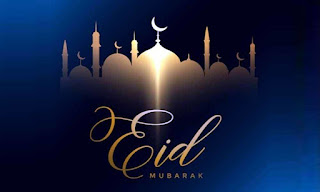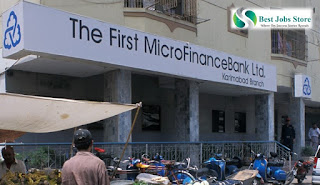EID-UL-FITR: A RELIGIOUS FESTIVAL CELEBRATED BY MUSLIMS OF THE WORLD
Eid al-Fitr [Arabic: عيد الفطر] also called the "Festival
of Breaking the Fast", is a religious holiday celebrated by Muslims
worldwide that marks the end of the month-long dawn-to-sunset fasting of Ramadan. This
religious Eid is the only day in the month of Shawwal during
which Muslims are not permitted to fast. The date for the start of any lunar Hijri
month varies based on when the new moon is sighted by local religious
authorities, so the day of celebration varies by locality.
Eid al-Fitr has a particular salat (Islamic prayer) that
consists of two rakats (units)
generally performed in an open field or large hall. It may only be performed in
congregation (jamāʿat) and features six additional Takbirs
(raising of the hands to the ears while saying "Allāhu ʾAkbar",
meaning "God is the greatest") in the Hanafi school
of Sunni Islam:
three at the start of the first rakat and three just before rukūʿ in the second rakat. Other
Sunni schools usually have twelve Takbirs, similarly split in groups of seven
and five. In Shia Islam, the salat has six Takbirs in the first
rakat at the end of qira'a, before rukūʿ, and five in the second. Depending
on the juristic opinion of the locality, this salat is either farḍ فرض (obligatory), mustaḥabb مستحب (strongly recommended)
or mandūb مندوب (preferable).
HISTORY
Eid al-Fitr was originated by the Islamic prophet Muhammad (PBUH). According to certain traditions, these festivals were initiated in Medina after the migration of prophet Muhammad (PBUH) to Mecca.
Anas, a well-known companion of the Prophet (PBUH), narrated that, when the
Prophet arrived in Medina, he found people celebrating two
specific days in which they entertained themselves with recreation and
merriment. At this, the Prophet remarked that Almighty has fixed two days of
festivity instead of these for you which are better than these: Eid al-Fitr and
Eid al-Adha.
GENERAL RITUALS
Traditionally, Eid al-Fitr begins at sunset on the
night of the first sighting of the crescent moon. If the moon is not observed
immediately after the 29th day of the previous lunar month (either because
clouds block its view or because the western sky is still too bright when the
moon sets), then the holiday is celebrated the following day. Eid al-Fitr is
celebrated for one to three days, depending on the country. It is forbidden to fast on the Day of Eid, and a
specific prayer is nominated for this day. As an obligatory act of charity,
money is paid to the poor and the needy (Arabic: Zakat-ul-fitr) before performing the ‘Eid
prayer.
EID PRAYER AND EIDGAH
The Eid prayer is performed in
congregation in open areas like fields, community centers, or mosques. No call to prayer is given for this
Eid prayer, and it consists of only two units of prayer
with a variable amount of Takbirs
and other prayer elements depending on the branch of Islam
observed. The Eid prayer is followed by the sermon and
then a supplication
asking for Allah's forgiveness, mercy, peace and blessings for all living
beings across the world. The sermon also instructs Muslims as to the
performance of rituals of Eid, such as the zakat. The
sermon of Eid takes place after the Eid prayer, unlike Friday prayer
which comes first before prayer. Some imams believe that listening to the
sermon at Eid is optional. After the prayers, Muslims visit their relatives,
friends, and acquaintances or hold large communal celebrations in homes,
community centers, or rented halls.
Sunni procedure
As ritual dictates, Sunnis praise
Allah in a loud voice while going to the Eid prayer: Allāhu Akbar, Allāhu
Akbar, Allāhu Akbar. Lā ilāha illà l-Lāh wal-Lāhu akbar, Allahu akbar walil-Lāhi
l-ḥamd. Recitation ceases when they get to the place of Eid or once the
Imam commences activities.
The prayer starts by doing "Niyyat"
for the prayer and then Takbir is said by the Imam and his followers. Next,
"Takbeer-e-Tehreema" is recited, followed by Allahu Akbar three
times, raising hands to the ears and dropping them each time, except for the
last when the hands are folded. Then the Imam reads the Surah-e-Fatiha and
other Surah. Then the congregation performs Ruku and Sujud as in other prayers. This
completes the first rakat. The congregation rises up and folds their hands for
the second rakat., during which the Imam recites Surah Fatiha and another
Surah. After this, three Takbirs are called out just before the Ruku, each time
raising hands to the ears and dropping them. For the fourth time, the
congregation says Allah o Akbar and subsequently goes into the Ruku. The rest
of the prayer is completed in the regular manner. This completes the Eid
prayer. After the prayer there is a khutbah.
Shia procedure
Prayer starts with the Niyyat
followed by five Takbirs. During every Takbir of the first rakat, a special Dua
is recited. Then, the Imam recites Sūrat al-Fātiḥah and Surat Al-'A`lá and the
congregation performs Ruku and Sujud as in other prayers. In the second Rakat,
the same above steps (five Takbeers, Sūrat al-Fātiḥah and Surat Al-'A`lá, Ruku
and Sujud) are repeated. After the prayer, Khutbah starts.
PRACTICES BY COUNTRY
Pakistan
In Pakistan, Eid al-Fitr is also referred to
as both Meethi Eid میٹھی عید ("Sweet
Eid") and Chhoti Eid چھوٹی عید ("Small
Eid"). People are supposed to give obligatory charity on behalf of each of
their family members to the needy or poor before Eid day or, minimally, Eid
prayer, allowing for all to share in the joy of Eid. At home, family members
enjoy special Eid breakfast with various types of sweets and desserts,
including Kheer
and the traditional dessert Sheer Khurma, which is made of vermicelli,
milk, butter, dry fruits, and dates. Eid is mainly enjoyed by the kids, as they
mostly receive money in cash called "Eidi"
as gift from their relatives and elders. People tend to get fresh and crisp banknotes
to gift children with. State Bank of Pakistan
issues fresh currency notes every year for this purpose.
Jordan
Jordanians decorate
their homes and prepare sumptuous meals for family and friends. They prepare
new clothes and shoes for the festival. Eid festivities in Jordan may vary
culturally depending on the region, but one common thread in all celebrations
is generosity and hospitality. It is a common Jordanian tradition for families
to gather at the patriarchal home after the Eid prayers. Before the special Eid
meal is served, young children will line up in front of each adult family
member, who dispense money as gifts to the children. This year Eid Al-Fitr is
on Sunday, 24th may 2020 in Jordan.
Saudi Arabia
Saudis
decorate their homes and prepare sumptuous meals for family and friends. They
prepare new clothes and shoes for the festival. Eid festivities in Saudi Arabia
may vary culturally depending on the region, but one common thread in all
celebrations is generosity and hospitality. It is a common Saudi tradition for
families to gather at the patriarchal home after the Eid prayers. Before the
special Eid meal is served, young children will line up in front of each adult
family member, who dispense money as gifts to the children.
Iran
In Iran, at the last days of the month
of Ramadan, several groups of experts representing the office of Ayatollah Khamenei
go to the different zones of the country to determine the date of Eid al-Fitr.
Iranian Muslims take part in the Eid al-Fitr prayer and pay the Zakat al-Fitr.
The Eid al-Fitr prayer, and the following sermon, has been led by Ayatollah
Seyyed Ali Khamenei, Supreme Leader of Iran, at Tehran's Imam Khomeini
Grand Prayer Grounds (Mossalla). The celebration is typically marked by a one-
or two-day national holiday.
Turkey
In Turkey, nationwide
celebrated holidays are referred to as bayram,
and Eid al-Fitr is referred to as both Şeker Bayramı ("Bayram of
Sweets") and Ramazan Bayramı ("Ramadan Bayram"). It is a
time for people to attend prayer services, put on their best clothes (referred
to as bayramlık, often purchased just for the occasion), visit all their
loved ones (such as relatives, neighbors, and friends), and pay their respects
to the deceased with organised visits to cemeteries. It is also customary for
young children to go around their neighborhood, door to door, and wish everyone
a "Happy Bayram", for which they are awarded candy,
chocolates, traditional sweets such as baklava and Turkish Delight,
or a small amount of money at every door.
Afghanistan
In the predominantly Sunni Muslim culture of Afghanistan,
Eid al-Fitr holds significant importance and is celebrated widely for three
days. The most common greeting is Kochnai Akhtar (Blessed Eid) in the
Pashto-speaking community. Afghans start preparing for the Eid al-Fitr festival
up to ten days prior by cleaning their homes (called Khana Takani in
Dari). Afghans visit their local bazaars to buy new clothes, sweets, and snacks
including Jelabi (Jalebi),
Shor-Nakhod (made with chickpeas), and Cake wa Kolcha (a simple
cake, similar to pound cake). On the day of Eid al-Fitr, Afghans will first
offer their Eid prayers and then gather in their homes with their families,
greeting one another by saying "Eid Mubarak" and usually
adding "Eidet Mobarak Roza wa Namazet Qabool Dakhel Hajiha wa Ghaziha,"
which means "Happy Eid to you; may your fasting and prayers be accepted by
Allah, and may you be counted among those who will go to the
Hajj-pilgrimage." Family elders will give money and gifts to children. It
is also common practice to visit families and friends, which may be difficult
to do at other times of the year. Children walk from home to home saying "Khala
Eidet Mubarak" ("aunt happy Eid"), and they receive cookies
or Pala. At night, multiple campfires are set around houses, sometimes
to the point that entire valleys may initially appear to be engulfed in flame. Celebratory
fire with automatic rifles, particularly tracer rounds, can also be expected in
high density.
Egypt
Egyptians spend the first day of
Eid al-Fitr to gather all family members and celebrate the Eid at public
gardens. It is customary for children to also receive an Eidi, a small
sum of money to be spent on activities throughout the Eid. Egyptians like to
celebrate with others, so the streets are always crowded during the days and
nights of Eid.
Tunisia
Since 2012, Tunisia
celebrates Eid for three days (with preparations starting several days
earlier), two of which are national holidays. Special biscuits, including Baklawa and several
kinds of "ka'ak",
are made to give to friends and relatives on the day.
Somalia
In Somalia and other Islamic
parts of the Horn region, Eid al-Fitr is observed by the Muslim
communities. Celebrations marking the event are typically accompanied by
elaborate banquets, where special dishes such as xalwo (halwo) and
buskut (buskuit) are served.
South Africa
In Cape Town, hundreds
of Muslims—each with something to share with others at the time of the breaking
of the fast—gather at Green Point in the evening of the last day of Ramadan
for the sighting of the moon. The Maghrib
(sunset) prayer is then performed in congregation and the formal moon-sighting
results are announced thereafter.
Sudan
In Sudan, where 97% of the population
is Muslim, preparations for Eid begin the last few days of Ramadan. For days, ka'ak
(sugar powdered cookies), bettifour (dry baked goods including dainty
biscuits, baked meringues and macaroons—whose name are derived from the French petit
four), and popcorn are baked in large batches to serve to guests and to
give to family and friends; dressy Eid clothes are either shopped for or sewn;
girls and women decorate their hands and feet with henna; and parts of the house may
even be painted. The night before Eid, the whole household partakes in cleaning
the house and yard and setting out the finest bedsheets, table cloths, and
decorations. On the day of Eid, men and boys (and occasionally women and girls)
will attend the Eid prayer. For the next 3 days, families will then visit each
other, extended family, neighbors, and close friends. In these short visits,
the baked goods, chocolates, and sweets are served, and often large lunches are
prepared for the visiting well-wishers. Children are given gifts, either in the
form of toys or money.
India
A panorama in 12 folds showing an imperial Eid al-Fitr
procession by Bahadur Shah II. Special celebratory dishes in India include Lachcha
or sivayyan, a dish of fine, toasted sweet vermicelli
noodles with milk and dried fruit.
Indonesia
Eid is known in Indonesia as Hari
Raya Idul Fitri, or more popularly as Lebaran,
and is a national holiday. People return to their home town or
city (an exodus known as mudik)
to celebrate with their families and to ask forgiveness from parents, in-laws,
and other elders. Festivities start the night before with chanting the Takbir
and lighting lamps. On the day itself, after Eid prayer in
the morning, zakat alms
for the poor are distributed in the mosques. People gather with family and
neighbors in traditional clothing and have a special Lebaran meal. Children are
given money in colourful envelopes. Later, it is common for Muslims in
Indonesia to visit the graves of relatives to ritually clean the grave. Muslims
also visit the living in a special ritual called Halal bi-Halal sometime
during or several days after Idul Fitri.
Malaysia, Singapore, Brunei and Thailand
In Malaysia, children are given
token sums of money, known as "duit raya", from their parents or
elders.
Myanmar
During Ramadan, in small towns
and big villages with significant Muslim populations, Burmese Muslim youth organize
singing teams called Jago (meaning "wake up). Jago teams usually do not
use musical instruments apart from the occasional use of harmonica mouth organs.
The roving groups of singers will take the tunes of popular Hindi movie songs,
replaced with Burmese lyrics and invocations about fasting, the principles of
Islam, and the benefits of Salat
China
In the People's Republic of
China, out of 56 officially recognized ethnic groups, Eid al-Fitr is celebrated
by at least 10 ethnic groups that are predominantly Muslim. These groups are
said to total 18 million according to official statistics, but some
observers say the actual number may be much higher. It is also a public holiday in China
in certain regions, including two Province Prefecture Level regions, Ningxia and Xinjiang. All
residents in these areas, regardless of religion, are entitled to either a
one-day or three-day official holiday. Outside the Muslim-majority regions,
only Muslims are entitled to a one-day holiday. In Xinjiang province, Eid
al-Fitr is even celebrated by the Han Chinese
population. During the holiday, supplies of mutton, lamb and beef are
distributed to households as part of a welfare program funded by government
agencies, public and private institutions, and businesses. In Yunnan, Muslim
populations are spread throughout the region. On Eid al-Fitr, however, some devotees
may travel to Sayyid 'Ajjal's grave after their
communal prayers. There, they will conduct readings from the Quran and clean
the tomb, reminiscent of the historic annual Chinese Qingming festival, in
which people go to their ancestors' graves, sweep and clean the area, and make
food offerings. Finally the accomplishments of the Sayyid 'Ajall will be
related in story form, concluded by a special prayer service to honour the
hundreds of thousands of Muslims killed during the Panthay Rebellion,
and the hundreds killed during the Cultural Revolution
Greece
Eid al-Fitr (i.e. Seker Bayram,
Sugar Feast) is celebrated in Greece mainly in the Western Thrace
region from the local Muslim minority (Turks, Pomaks
and Roma), along with the other two major celebrations, Kurban Bayram
(Sacrifice Feast) and Hıdırellez. On
the day of the Bayram, family gathers together, wear their best clothes, and
celebrate with a common meal, after attending the morning prayer. The women
prepare and offer sweets to family and visitors, while small children go around
and pay their respects to the elderly by kissing their hands. The elder in turn
reward them with candies, sweets, and small amounts of money. Local Muslim
shopkeepers close their shops this day, while Muslim minority schools have a 5-day holiday for the
feast. Some entertainment venues and clubs hold special events for the night of
the Bayram.
United Kingdom
Although Eid al-Fitr is not a
recognized public holiday in the United Kingdom, many schools, businesses, and
organizations allow for at least a day's leave to be taken for religious
celebrations. As in Egypt, there have been a small number of reports of historic
sexual assaults associated with the Eid in the UK.
United States
In New York City, alternate side
parking (street cleaning) regulations are suspended on Eid. Beginning in 2016,
New York City Public Schools also remain closed on Eid. In Houston,
Texas, the annual prayers are offered at the George R. Brown Convention Center
in downtown Houston, organised by the Islamic Society of Greater Houston
(ISGH). In other states, with smaller Muslim populations, it is common that
schools will remain open on Eid al-Fitr.
The United States Postal Service (USPS) has issued
several Eid postage stamps, across several years—starting in 2001—honoring
"two of the most important festivals in the Islamic calendar: Eid al-Fitr
and Eid al-Adha." Eid stamps were released in 2001 – 2002, 2006 – 2009,
2011.
SOURCES
1. Encyclopedia of
Islam and the Muslim World. Edited by Martin, Richard C.
Macmillan Reference, 2004. Vol. 1.









Comments
Post a Comment